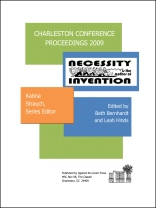Plato’s Republic was the inspiration for the theme of the 2009 Charleston Conference on Issues in Book and Serial Acquisition: Necessity is the Mother of Invention. The conference, held November 4-7, 2009, in Charleston, SC, included 10 pre-meetings, over 15 plenary sessions, and over 120 concurrent sessions. The theme reflected the changes and innovations that are taking place in collection development and acquisition activities as libraries expand services in the global marketplace while wrestling with tough economic times, including budget cuts, furloughs, and cancelation of some resources. Librarians are looking for ideas and innovation. The Charleston Conference meets that need, as attendance indicated at the 2009 occurrence of this major event for information exchange among librarians, vendors, and publishers.
Зміст
Preface and Acknowledgements, by
Introduction, by
Plenary Sessions
New Librarianship, by David Lankes, and reported by Jonathan H. Harwell
Pricing Digital Journals, by Adam Chesler, Christopher Mc Kenzie, Tony O’Rourke, and David Stern, and reported by Mary E. Marshall
“Raising Spirits in This Tough Economy”: Results from CIBER’s Global Library Survey, by David Nicholas,
Christopher Warnock, and Mark Kendall, and reported by Tony G Horava
I Hear the Train a-Comin’: Switches, Cars, the Academy and the Web Train Network, by Greg Tananbaum, Douglas Armato, and Kevin Guthrie, and reported by Kevin Guthrie
“It’s the Economy, Stupid”: Dealing with High Acquisition Goals in Low Economic Times, by
Mehdi Khosrow-Pour, James Wiser, Robert L. Watkins, John G. Dove, Wendy Shelburn, Lia Hemphill, and Kevin Sayer, and reported by Heather S. Miller
Discovery versus Disintermediation, by Jane Burke, and reported by Anna Fleming
Our Common Future, by Ivy Anderson, and reported by Audrey Powers, University of Florida
The Google Settlement One Year Later, by Anthony Watkinson, Jan Constantine, Allan Adler, and reported by Sharon Dyas-Correia
Open Access: Readership and Citations, by Phil Davis, and reported by Ramune K. Kubilius
Hyperlinked Library Service: Trends, Tools, Transparency, by Michael Stephens, and reported by Heather S. Miller
Lightning in a Bottle: Libraries, Technology and the Changing System of Scholarly Communications, by Kevin L. Smith
Preconferences
Ebrarians: Meeting the Challenges of E-resources Head on! New Professionals Discuss the Management of Electronic Resources, by Ryan Weir, Geoffrey P. Timms, George Stachokas, and Regina Koury
Budget
“Ten More Accounting Text Books!: Turning Those Unwanted Gift Books into Good Donor Relations” , by Thomas A. Karel
Library Acquisitions Accounting, by Rachel Kirk
Never Let a Serials Crisis Go to Waste: Building Support for Library Collections at Virginia Tech, by Edward Lener and Connie Stovall
Streamlining the Materials Ledger to Reflect the Realities of Campus Demographics, Collection Use, and the Increase in E-Resource Expenditures, by Anne C. Elguindi, Michael Matos, and Kari Schmidt
Tightening the Core: Using Circulation and Cost History to Reduce Spending on a Research Library’s Central Approval Plan, by Richard Entlich and Maureen Morris
Tying Information Literacy Learning Goals to a Library Materials Budget: Repackaging the Formula to Meet Learning Goals, by Dawn Stephen and Jenny Rushing
Collaboration
Cooperative Collection Development: Sharing Funds, Resources, and Responsibilities Across Libraries: A Pilot Program in Nursing, by Kay Downey
Sharing the Load: Alternatives to Buying What Users Need, by Lynne Branche Brown, Nancy Beals, and Beth Callahan
The Evolution of Business Sources: An Environmental Look at Information Providers and a Prediction for the Future or “It’s really not so bad, and it’s gonna get better!”, by Jean Yaremchuk
Content Development
Are They Being Indexed II? A Follow-Up to Tracking the Indexing and Abstracting of Open Access Journals, by Jack Fisher and Elaine Yontz
Beguiled by Bananas: A Retrospective Study of the Usage & Breadth of Patron vs. Librarian Acquired Ebook Collections, by Jason Price and John Mc Donald
Cost/Benefit Analysis of Bio Med Central Membership at a Large Research Institution, by Susan Klimley
Grappling with Changing Realities, by John Stratton, Lea Currie, Monica Claassen-Wilson, and Frances Devlin
Is Good Enough, Really Good Enough? Does algorithmic metadata search replace the need for discipline-oriented databases?, by Mark Hyer, Helen Ivy, Bruce Pencek, Sharon Jordan, and Sharon Tahirkheli
It’s Raining Cats and Citation Analyses: New uses and audiences for the results of evidence-based collection evaluation, by Alison M. Bobal and Andrea A. Wirth
Moving to a Virtual Approval Plan: How an ARL Library is Leveraging Funds and Streamlining Workflow, by Yem Fong, Kim Anderson, and Charlene Kellsey
Reconfiguring Collection Development: A Faculty Print Serials Review, by Audrey Powers, Matt Torrence, and Jared Hoppenfeld
The Digitization of the “Michigan Pioneer and Historical Collections:” A Case Study, by Michael E. Unsworth
Tools you can use: Lib X as an Assistant for Collection Development, by Kyrille Goldbeck
The Future of the “Book” in Light of the Present Rise in “E” Publications, by Joyce Dixon-Fyle
Uniqueness and Collection Overlap in Academic Libraries, by Michael Levine‐Clark, Margaret Jobe, and Sara Holladay
Using Access to Create a Serials Review Database, by Hana Levay
Education
Collection Management 101: Developing and Implementing a Workshop Series, by Meris Mandernach
Discover the Profession’s Best-kept Secret . . . and Protect Your Investment in Collections, by Becky Kornegay, Heidi Buchanan, and Hiddy Morgan
Using i Clickers in Library Instruction to Improve Student Engagement, by Bobby Hollandsworth and Ed
End Users / Use Statistics
A Novel Approach to Relating Resource Expenditures to Academic Units, by Cory Lown
Impact Factors, Post-Publication Peer Review and Other Metrics, by Richard P. Grant
Let the Data Speak: Use Statistics and Collection Management, by Laura Crain
Making the most of the Center for Research Libraries: A Members Roundtable, by Mary Claire Vandenburg, Sylvia Andrychuk, and Mary I. Wilke
The Semantic Web: What You Need to Know and Why It Is Important For Your User Community, by Darrell Gunter, Terry Hulbert, Thane Kerner, and Steve Leicht
Usage Statistics: The Perks, Perils and Pitfalls, by Christine M. Stamison, Nick Niemeyer, and Cory Tucker
What Counts? Assessing the Value of Non-Text Resources, by Tammy S. Sugarman, Louise Kelly, and Stephanie Krueger
What We Learned From Users: Lessons Learned From Our Student Users, by Nancy King
Format
e-Duke Books: What Have We Learned?, by Ann-Marie Breaux, Michael Mc Cullough, Lois Schultz, and Tammy S. Sugarman
Good Enough: The New Face of Reference, by Doug Way and Colleen Lyon
Let Me See That e Book: Managing Cataloguing and Access through Collaboration, by Aaron Wood, Anne Harris, Jim Shetler, and Aron Wolf
Microforms in a Digital World, by Tinker Massey
Open Access Collections: What Is Your Number? , by Anjana H Bhatt
Towards Resolving Chaos in the e‐Book Supply Chain, by Ann‐Marie Breaux, Brian Green, and Mark Bide
Management
Blogs, Wikis, and Drives Oh-my! Achieving Knowledge Management for Acquisitions & Collection Development with Web 2.0 Technologies, by Denise Pan and Yem Fong
Collegiality Matters: How Do We Work with Others?, by Shin Freedman
Communication and Collection Accountability through Clusters: Case Studies from Two Institutions, by Carla Lee and Meris Mandernach
Growing Your Own: Developing New Acquisitions and Collection Development Librarians From Within, by Jennifer Arnold
How Are We Doing? Implementing Acquisitions Metrics in Pursuit of Improved Service, by Cheri Duncan
How ‘Necessity’ Has Changed the Way Acquisitions is Done at One Academic Library, by Shelley Hawrychuk
It Takes a Village to Raise an E-Journal: Collaboration through Necessity, by Wendy West and Katherine Latal
The Out-of-Print Book Market and the Theft of Library Materials, by Robert P. Holley
Tracking Electronic Resource Acquisitions: Using a Helpdesk System to Succeed Where Your ERMS Failed, by Xan Arch and Jason Price
Transformational Change: The 9th Annual Health Science Lively Lunch, by Ramune K. Kubilius, Pat Thibodeau, and Meg White
Weeding with a Repurpose, by Michael Crumpton and Mary Krautter
Out of the Box Thinking
Delivering the Goods: Understanding the Academic Library Supply Chain, by Adam Wathen
Digital Curation and E-Publishing: Libraries Make the Connection, by Sayeed Choudhury, Mike Furlough, and Joyce Ray
Disrupting Libraries: The Potential for New Services, by Ken Chad
Getting It System Toolkit (GIST): The GIST of Making Informed Decisions and Workflow of Buying, Borrowing, Downloading or Viewing, by Kate Pitcher, Tim Bowersox, Cyril Oberlander, and Mark Sullivan
Interactive Online Reference, by Tom Beyer and Sue Polanka
Law Libraries: “Our Perspective on Necessity is the Mother of Invention”, by Ed Hart, Paula Tejeda, and Michelle Pearse
Learning to Love Gifts: How One Library Has Increased Efficiency in Processing, and Realized the Benefits of Gift Materials, by Michael A. Arthur
Leveraging Assets: How BCR, Bibliolife and Ingram Came Together to Help Libraries through the Shelf2Life Program, by Gillian Harrison Cain, Mitchell Davis, Michael Levine-Clark, and Mark Mc Quillan
Publishing Data Alongside Analysis, Books and Journals, by Toby Green
Rethinking Monographic Acquisition: Developing a Demand‐Driven Purchase Model, by Michael Levine‐Clark, Stephen Bosch, Kim Anderson, and Matt Nauman
(R)Evolution in the Information Industry: What the Information Industry Can Learn from the Music Industry, by Amy Elliott
Success Strategies for Thesis Students: Creating a Video Toolbox, by Claudia J. Dold and Ardis Hanson
The Changing Roles of Acquisitions Librarians and the e Book Acquisitions Landscape for Academic Libraries, by Dung-Lan Chen and Lorie Wies
The Chicago Collaborative: Facing the Grand Challenges of Scholarly Communication, by Tom Richardson, Irving Rockwood, John Tagler, and Patricia Thibodeau
Two for One: Linking Cooperative Collection Development with Demand-Driven Collection Strategies, by Austin Booth and Kathleen O’Brien
Will POD (Print on Demand) Spell DOA for OP?, by Mitchell Davis, Peter V. Tafuri, John Riley, Narda Tafuri, and Marcus Woodburn
Techie Issues
A Necessity: Outsourcing the Issues of Print Serials, by Heather D’Amour, Ada-Marie Atkins Nechka,
Gloria Dingwall, and Umashanie Reddy
Academic Libraries without Print, by Allen Mc Kiel, Jim Dooley, and Robert Murdock
Copyright on Campus: Coordinating the Confusion, by Christine Ross
From Pilot to Production: Video Streaming at Indiana University, by Jo Mc Clamroch
Next Gen Acquisitions: A Paradigm Shift for a New Era, by Kelly Smith and Kathryn B. Harnish
Populating and Synchronizing Serials Solutions Resource Manager 360 with SFX data: Experiences from the Field, by Tony Harvell
We Need All the Help We Can Get! – Standards That Assist in Electronic Resources Management, by Betty Landesman
Про автора
Katina P. Strauch is Head of Collection Development at the Addlestone Library, College of Charleston, founder of the Charleston Conference, and editor of
Against the Grain, the journal for libraries, publishers, and vendors, which is published six times a year; Beth R. Bernhardt is Electronic Resources Librarian at the Jackson Library, University of North Carolina at Greensboro; and Leah H. Hinds is Assistant Director of the Charleston Conference.












